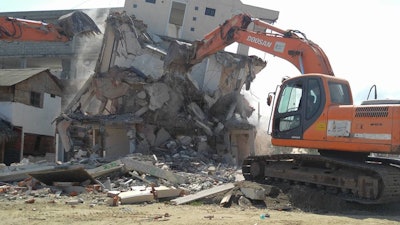
Information from this article was first published in Demolition Magazine and is being reused with permission from the National Demolition Association.
By Liam Hartman and Bill Argue
On the evening of April 16, 2016, an earthquake measuring 7.8 Mw on the Richter scale occurred off the coast of Ecuador. A small country of approximately 16 million people, Ecuador lies between Colombia and Peru on the Pacific coast of South America, and while the country is no stranger to the hazards of earthquakes along the Ring of Fire, this quake turned out to be the largest recorded in Ecuador since 1979. Centered near the town of Muisne, Manabí, the far-reaching destruction of this tectonic event devastated settlements, towns and cities up and down the coast.
No fewer than six coastal provinces immediately declared states of emergency. The most harshly affected areas lost all electricity, land-based telecommunications and cellular services. Six hundred miles of roads were destroyed and, coupled with the breakdown in communications, left the affected areas isolated and effectively cut off from emergency services. As official reports slowly and sporadically made their way in, the world became aware of the fallout of 660 deaths, 4,600 injured and roughly 80,000 homeless due to this natural disaster. As losses amounted to more than $3 billion governments, corporations and individuals from around the globe responded to the call for help.
Liam Hartman, a project manager with Toronto-based Mitchell Demolition Inc., had spent several years living in Ecuador, where he pursued his master’s thesis research in disaster and emergency management. Previous research had focused on seismic activity and tsunami risk in Ecuador, specifically taking him to the small town of Canoa, located in the province of Manabí — also devastated by the earthquake. Life is stranger than fiction, and Hartman’s specific education combined with his training at Mitchell made for a perfect combination, and Mitchell Demolition and Hartman felt compelled to assist. Upon confirming the worst from contacts in Ecuador, Hartman made a call to the company president, Kevin Mitchell. Mitchell Demolition expedited Hartman’s replacement on an active project, funds were provided — both as donations and to facilitate Hartman’s accommodation and travel — and the wheels were set in motion to allow Hartman and Mitchell Demolition to assist as best they could with the emergency efforts.
Arriving in Canoa late in the afternoon on April 30 to temperatures reaching over 95 degrees Fahrenheit, Hartman was escorted by security personnel from the United States Embassy and driven to the coast from Quito, Ecuador’s capital city, along with two trucks full of humanitarian aid. Just outside of Canoa, their convoy encountered a large landslide blocking off several miles of roadway, forcing a diversion onto a makeshift road leading to the beach. Upon arriving, Hartman met with his friends and contacts in Canoa, at the home of Peter and Maija Stromberg, U.S. citizens who have called Ecuador home since 2008. Their home, partly damaged by the earthquake, and occupied by the Ecuadorian Army Corps of Engineers, buzzed with military helicopters constantly arriving and departing, and soldiers demobilizing equipment, preparing to relocate to a new command center.
After visiting the town, assessing the destruction and viewing the many makeshift refugee camps strewn about the town limits, Hartman began to organize groups of expatriates and locals who had been working independently toward common goals. Many of these tasks were directed toward first response actions, helping people get to safety, pulling others from collapsed buildings, distributing supplies and building temporary shelters.
Choosing the name Canoa Reviva to represent the newly formed group, Hartman and his team proceeded to establish a civilian incident command center, focusing not only on the demolition of damaged buildings, but also in providing water and sanitation, humanitarian aid distribution and community engagement, as well as participating in the long hours of meetings with local, provincial and federal government agencies. Hartman, drawing on his experience with Mitchell Demolition, outlined efforts to help make the town safer. Focusing on the demolition of precarious damaged buildings, those which were ready to fall at the smallest of the inevitable aftershocks, was job one. Enlisting the help of retired Ecuadorian civil engineer Santiago Echeverría and former U.S. firefighter and Canoa resident Erik Wenz, a specialist in urban disaster scenarios, they worked with the understaffed local municipal agency in charge of the post-disaster landscape. The Canoa Reviva team began locating, identifying and mapping out damaged buildings; assessing for structural integrity; and coordinating the controlled hand and mechanical demolition and salvage of some 50 buildings. These ranged from small personal residences to five-story hotels.
In concert with the Ecuadorian military and local construction company Fopeca, Canoa Reviva employed three excavators, a Doosan 225 & 340 and a Komatsu PC 200 LC, along with a JCB 3C Loader Backhoe, a variety of skid steers and dozens of dump trucks to remove the massive amounts of debris. One hundred and fifty local workers were pressed into service and sponsored by U.S. - based charity Ecuador Earthquake Relief Fund and Ecuadorian Pharmaceutical company Finalin, which were charged with the hand demolition and salvage of many low risk damaged buildings.
An unfortunate reality of underdeveloped settlements worldwide is that many buildings are erected with no consideration of proper codes and lacking proper engineering. Most of the buildings encountered here were made with poor quality block, manufactured with ocean sand and had little to no rebar. What rebar was uncovered was rusted due to the salt in the construction materials. This was all too evident due to the pancaking of even the newest buildings in the earthquake zone. Ironically, many of the buildings constructed of local native materials such as wood and bamboo, with roofs of thatched leaves, fared well against the effects of the earthquake. However, some of the houses raised off the ground, top heavy with improperly built block walls, fell by up to 10 feet, as the unsupported wooden or concrete pillars quickly fell victim to the sheer intensity of the quake. In addition to these building limitations, many structures were not shown on maps and roads often carried several different names, further complicating matters.
Hartman’s group achieved a seemingly impossible feat: coordinating and organizing the demolition of several four- to five-story buildings in the main urban area that surrounded a local restaurant, the Surf Shak, which held historical and personal significance for the expatriate community, without damaging the smaller enclosed building. Being one of the oldest buildings in Canoa, it was surrounded on three sides by larger damaged buildings looming over it. On the night of the earthquake, the building to the north, an older wooden structure, collapsed completely. Luckily, none of the residents who were inside at the time or the patrons in front of the restaurant were hurt. The other two buildings to the south and east were concrete structures, with critical column cracks and most of the shear capacity removed from the original quake.
Due to the time of the year — the end of the tourist season — many owners of the building were absent at the time. Locating owners or their representatives proved to be a difficult task, as many fled the area or could have been one of the many victims. However, the group’s deep connections in the community allowed them to locate the owners or their family in order to get required permissions to demolish and neutralize the dangerous building, reaching out to several owners via satellite phone in the United States and Europe.
Because of the limited resources available, Hartman’s team made do with what they had. Establishing a perimeter around the two buildings, recruiting some of the limited local police to help secure the area, Fopeca employed two excavators to strip the building to columns and slab; surgically, they began undermining supporting columns, ultimately causing the buildings to collapse inwards within the buildings envelope.
A lack of an established demolition industry in this part of the country, along with zero architectural or structural drawings, trained professionals and limited, often dilapidated machinery led to many breakdowns and pitfalls into hidden septic tanks, but the combination of know-how and years of experience from Fopeca and volunteer project managers succeeded in overcoming the odds. Utilizing a ramshackle crew of local contractors and military machinery, a team of 150 local, inexperienced labor force and helpful volunteers, donated tools and local leaders, Canoa Reviva worked at making the town safe for the inhabitants and cleared the way for reconstruction, while the country waited for the Ecuadorian government to compose themselves.
Hartman, now back in Canada, continues to work with Mitchell Demolition in Toronto, but also continues to work directly with Canoa Reviva, administering the organization, which has now become a network for the many humanitarian groups operating in Canoa, Ecuador, to this day.


















